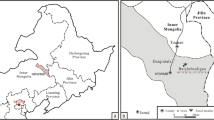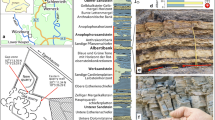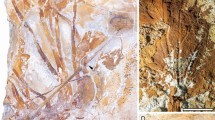Abstract
A morphologically more diverse assemblage of Longfengshaniaceae has been found in the uppermost Ediacaran (Sinian) Jiucheng Member, Yuhucun Formation at Jinning and Jiangchuan, eastern Yunnan, South China. A majority of them are different from the Longfengshania found in the Neoproterozoic Changlongshan Formation, Yanshan Mountain area, North China and the Little Dal Group, North America. They are mainly characterized by a more varied, often thallus-like appearance with no branches, such as oval, pyriform, spindle, shovel, heart, ribbon and balloon shapes, and more sturdy stalk-like projection (stipe) with a smooth connection on the basal part of the thallus. In addition, they appear to have a remarkable attaching organ of lanceolate, shuttle-like or short stem-like structure at the base of the stipe. Six distinct morphological taxa are recognized, including one new genus, two new species and three conformis species. The characteristics of the family and the genus Longfengshania are further discussed in this paper. The new discoveries of these carbonaceous macrofossils identified as Longfengshaniaceae algae on the basis of the diagnostic forms and anastomosis patterns of their thalli and stipes demonstrate that an important evolutionary radiation of metaphytes took place in the last Ediacaran stage. The flourishing of the benthonic thallophytes attached to the substrate from eastern Yunnan and considered to be photosynthetic alga probably provided continuous nutritional habitats for the explosion and diversification of the Early Cambrian “Chengjiang biota”.
Similar content being viewed by others
References
Calver C R (2004). U-Pb zircon age constraints on Late Neoproterozoic glaciation in Tasmania. Geology, 32(10): 893–896
Chen J Y (2004) The Dawn of Animal World. Nanjing: Jiangsu Science and Technology Press, 1–366 (in Chinese)
Chen J Y, Cheng Y N, Iten H V (1997). The Cambrian Explosion and the Fossil Record. Taichung: Bulletin of the National Museum of Natural Science (Taiwan), 1–319
Chen L Z, Luo H L, Hu S X, et al (2002). Early Cambrian Chengjiang Fauna in Eastern Yunnan, China. Kunming: Yunnan Science and Technology Press, 1–199 (in Chinese)
Chen M E, Zheng W W (1986). Huainan biota of pre-Ediacaran. Geological Sciences, 3: 221–231 (in Chinese with English abstract)
Du R L (1982). The discovery of the fossils such as Chuaria in the Qingbaikou System in Northwestern Hebei and their significance. Geological Review, 28(1): 1–7 (in Chinese with English abstract)
Du R L, Tian L F, (1985). Preliminary research of the macroalgae Longfengshania from Qingbaikou System, Yanshan areas. Acta Geologica Sinica, 59(3): 183–190 (in Chinese with English abstract)
Du R L, Tian L F (1986a). The Macroalgal Fossils of Qingbaikou Period in Yanshan Range. Shijiazhuang: Hebei Publication House of Science and Technology, 1–114 (in Chinese with English abstract)
Du R L, Tian L F (1986b). The macroscopic algae fossils from Qingbaikou System in the Yanshan Mountain areas, China and their stratigraphical significance. Precambrian Geology, 3: 495–511 (in Chinese with English abstract)
Fott B, (1980). Algenkunde. Translated by Luo D A. Shanghai: Shanghai Publishing House of Science and Technology, 1–534 (in Chinese)
Hofmann H J (1985). The Mid-Proterozoic Little Dal macrobiota, Mackenzie Mountains, North-West Canada. Palaeontology, 28(2): 331–354
Liu Z L, Du R L (1991). Morphology and systemics of Longfengshania. Acta Palaeontogica Sinica, 30(1): 106–114 (in Chinese with English abstract)
Luo H L, Jiang Z W, Wu X C, et al (1984). Chinese Yunnan Jinning Meishucun Sinian-Cambrian Section of Boundary Line. Kunming: Yunnan People’s Press, 1–154 (in Chinese with English abstract)
Luo H L, Wu X C, Ouyang L, et al (1988). New correlation opinions on the sections of Sinian-Cambrian boundary in the Yangtze platform. Yunnan Geology, 7(1): 13–27 (in Chinese with English abstract)
Narbonne G M, Gehling J G, (2003). Life after snowball: The oldest complex Ediacaran fossils. Geology, 31(1): 27–30
Steiner M, Erdtmann B D, Chen J Y (1992). Preliminary assessment of new Late Sinian (Late Proterozoic) large siphonous and filamentous “megaalgae” from eastern Wulingshan, North-central Hunan, China. Berliner Geowiss, Abh, E, 3: 305–319
Tang F (1995) Macroalgal fossils of Changlongshan stage in Beijing region and their significance. Professional Papers of Stratigraphy and Palaeontology, 26: 24–34 (in Chinese with English abstract)
Tang F, Yin C Y, Gao L Z (1997). A new idea of Sinian Doushantuo’an Metaphyte fossils from Xiuning Anhai Province. Acta Geologica Sinica, 71(4): 491–501
Tang F, Gao L Z (1998). Sinian biota in China. Acta Geologica Sinica, 72(3): 193–204 (in Chinese with English abstract)
Xiao S, Yuan X, Steiner M, et al (2002). Macroscopic carbonaceous compressions in a terminal Proterozoic shale: Systematic reassessment of the Miaohe biota, South China. Journal of Paleontology, 76(2): 347–376
Xing Y S (1985). The discovery and stratigraphical significance of the Sinian macroscopic algae near to Kunming, Yunnan. Bulletin of the Institute of Geology, Chinese Academy of Geological Sciences, 12: 118 (in Chinese with English abstract)
Xing Y S, Duan C H, Liang Y Z, et al (1985). Late Precambrian Palaeontology of China. Beijing: Geological Publishing House, 1–243 (in Chinese with English summary)
Xu Z L (2001). New discoveries of Phaeophycean fossils in the Early Cambrian, Haikou, Kunming, Yunnan, Southwest China. Acta Botanica Sinica, 43(10): 1072–1076
Xu Z L (2002) The occurrence of Longfengshania in the Early Cambrian from Haikou, Yunnan, China. Acta Botanica Sinica, 44(10): 1250–1254
Yin C Y, Gao L Z (2000). The discovery and geological significance of macroscopic algae in the Luoyu Formation, Lushan Mountain area, western Henan. Acta Geologica Sinica, 74(4): 339–343 (in Chinese with English abstract)
Yuan X L, Li J, Cao R J (1999). A diverse metaphyte assemblage from the Neoproterozoic black shales of South China. Lethaia, 32: 143–155
Yuan X L, Li J, Chen M E (1995). Development and their fossil records of metaphytes from Late Precambrian. Acta Palaeontogica Sinica, 34(1): 90–102 (in Chinese with English abstract)
Yuan X L, Xiao S H, Yin L M, et al (2002). Doushantuo Fossils: Life on the Eve of Animal Radiation. Hefei: University of Science and Technology of China Press, 1–171 (in Chinese)
Zang W L (1992). Sinian and Early Cambrian floras and biostratigraphy on the South China platform. Palaeontographica, Abt B, 224: 75–119
Zhang Z Y (1988). Longfengshania Du emend: An earliest record of bryophyte-like fossils. Acta Palaeontogica Sinica, 7(4): 416–425 (in Chinese with English abstract)
Zhao Y L, He M H, Chen M E, et al (2004). New discovery of the Miaohe biota from the Neoproterozoic Doushantuo Formation at Jiangkou, Guizhou. Chinese Science Bulletin, 49(18): 1916–1918 (in Chinese)
Author information
Authors and Affiliations
Corresponding author
Additional information
Translated from Acta Geologica Sinica, 2006, 80(11): 1643–1649 [译自: 地质学报]
Rights and permissions
About this article
Cite this article
Tang, F., Song, X., Yin, C. et al. Discoveries of new Longfengshaniaceae from the uppermost Ediacaran in eastern Yunnan, South China and the significance. Front. Earth Sci. China 1, 142–149 (2007). https://doi.org/10.1007/s11707-007-0018-1
Issue Date:
DOI: https://doi.org/10.1007/s11707-007-0018-1




